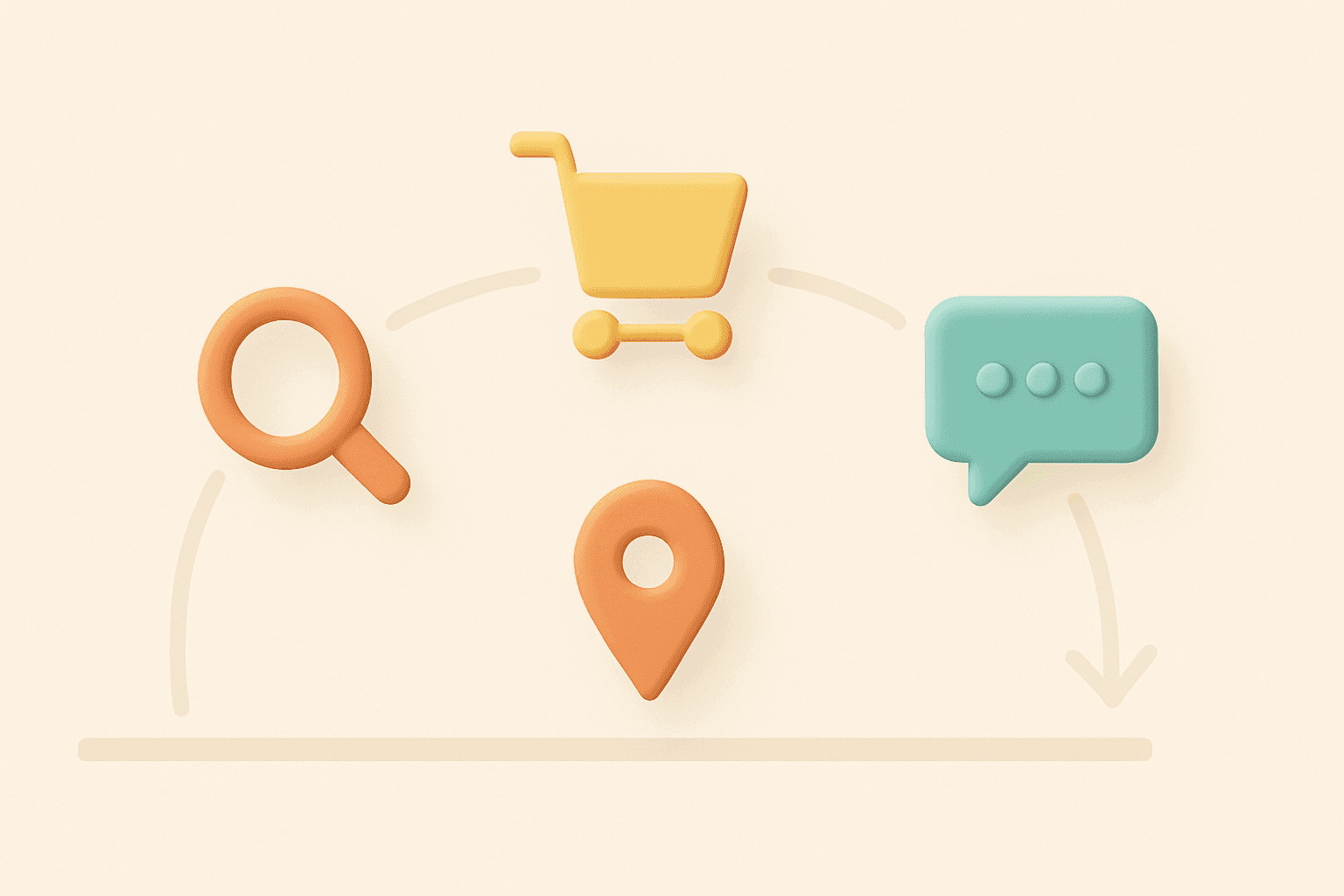Omnichannel vs Unified Commerce: Enterprise Decision Guide (2025)
Omnichannel and unified commerce are two competing retail architectures shaping how enterprise and mid-market brands engage modern consumers. As commerce stacks grow more complex, technology leaders are being pushed to choose between stitching together multiple systems—or consolidating everything into a single, real-time platform.
Today, this distinction shapes how you operate, compete, and serve customers.
-
Omnichannel commerce integrates multiple sales and service channels but often suffers from platform sprawl, data fragmentation, and non-synchronized workflows.
-
Unified commerce, by contrast, brings all channels, customer data, and fulfillment logic into one system—enabling real-time orchestration, personalized journeys, and faster innovation.
If your business is struggling with disconnected systems, slow personalization, or escalating maintenance costs, this guide will help clarify which architecture fits your growth roadmap.
We’ll now compare both models across technology stacks, data architecture, CX performance, and implementation realities—so you can move forward with confidence.
Is Omnichannel Still Relevant in 2025?
Yes, but only under certain conditions.
If you’re running on legacy infrastructure, need to support a wide range of regional systems, or your digital maturity roadmap is still evolving, omnichannel can still serve you—with the right governance. It’s not broken; it’s just brittle under scale.
What’s changed in 2025 is the cost of orchestration.
Maintaining separate systems stitched together by middleware is no longer “good enough” when:
-
Real-time personalization is table stakes
-
Customer expectations reset with every best-in-class experience
-
Ops teams are drowning in integration tickets and sync issues
So yes, omnichannel is still relevant—but the bar for making it work is higher than ever. It demands tight operational discipline and architectural compromise. Unified commerce doesn’t replace it because it’s trendier; it replaces it when the complexity of your business outgrows the fragmented approach.
If you’re not there yet, omnichannel might still be a valid phase. But if you’re already feeling the cracks—chances are, you’ve outgrown it.
Where Omnichannel Breaks—and When Unified Commerce Makes Sense
Customer behavior has outpaced omnichannel coordination
Shoppers today move across six or more touchpoints during their purchase journey. This is a sharp rise from just two decades ago. Omnichannel helped close that gap for a while, with strong gains: higher in-store visits, increased average spend, and more consistent brand messaging.
But what’s changed is the baseline expectation. Customers now expect everything to work in sync—inventory, promotions, fulfillment, service—across every touchpoint, in real time.
And this is where omnichannel systems start to show strain.
Where Omnichannel Starts to Crack
Retailers operating at scale are running into friction points that omnichannel simply wasn’t built to handle:
-
Disconnected data across POS, eCommerce, CRM, and loyalty tools
-
Inconsistent experiences between physical and digital channels
-
Integration slowdowns from brittle middleware and point-to-point setups
-
Rising cost of coordination as systems multiply across geographies
We can't write them off as minor inconveniences. They directly impact your ability to personalize, innovate, and respond to real-time customer behavior.
When Unified Commerce Becomes the Logical Evolution
Unified commerce is basically a re-architecture of your entire commerce stack. By consolidating sales channels, customer data, inventory, and fulfillment into a single, cloud-native, API-first platform, leading retailers are seeing measurable gains:
-
27% lower fulfillment costs
-
18% reduction in cart abandonment
-
Consistent cross-channel CX and unified customer profiles
-
Faster rollout of new capabilities across global markets
If your teams are spending more time syncing systems than serving customers, you’ve likely outgrown omnichannel—and unified commerce becomes the more sustainable path forward.
Not Every Brand Needs to Switch—Yet
If your business is still regional, less reliant on real-time data, or tightly governed, the omnichannel may still work with the right oversight. But once personalization, complexity, or scale starts pushing back against your architecture, you’ll know.
Unified commerce isn’t the answer for everyone.
But for retailers struggling to unify data, personalize at scale, and operate efficiently across markets—it’s the architecture that fits the ambition.
Omnichannel Commerce Explained: Channels, Benefits & Limitations
Omnichannel commerce is a retail strategy where brands integrate multiple sales and communication channels—such as websites, mobile apps, in-store systems, and marketplaces—to deliver a consistent customer experience. Unlike multichannel setups, where channels function in isolation, omnichannel models aim for coordinated experiences through connected—but often independently managed—systems.
Core Characteristics of Omnichannel Systems
Modern omnichannel architectures are designed to support cross-channel consistency using separate but integrated systems. The key components include:
-
Inventory visibility across physical and digital stores (e.g., store pickup, ship-from-store, real-time stock updates)
-
Synchronized pricing and promotions across ecommerce, mobile, and brick-and-mortar channels
-
Distributed order management, enabling fulfillment and returns from multiple locations
These capabilities have helped retailers improve channel coordination and meet customer expectations across touchpoints.
Operational and Data Limitations
Despite its advantages, omnichannel commerce still relies on a fragmented backend structure. From what we have discovered, these are the enterprise-level challenges:
-
Platform-bound data silos that create inventory lags and slow customer updates
-
Disconnected workflows between ecommerce, POS, and fulfillment systems
-
Complex integration processes when adding new touchpoints or systems
-
Inconsistent customer identities across platforms, leading to disjointed experiences
-
Delayed updates to pricing, availability, and promotions across channels
These constraints limit speed, personalization, and scalability—especially for retailers managing multiple brands, regions, or fulfillment networks.
While omnichannel commerce was a meaningful step toward coordinated CX, its siloed infrastructure creates friction and operational complexity that make it difficult to meet real-time expectations in 2025.
What is Unified Commerce? Definition, Features, and Tech Stack
Unified commerce is a real-time retail architecture that consolidates all sales channels, customer data, inventory, and fulfillment into a single, centralized platform. Unlike omnichannel systems that coordinate siloed technologies, unified commerce ensures that every customer interaction, transaction, and data point is processed and synchronized through one cohesive ecosystem.
This model is built for enterprise and mid-market retailers managing complex operations—think multi-brand businesses, global inventory networks, and highly personalized CX requirements. Brands like Nike, Sephora, and H&M have embraced unified commerce to deliver consistent, scalable experiences across web, mobile, stores, and marketplaces.
Unified Commerce Features and Architecture
Unified commerce platforms are typically built on modern, composable foundations. They focus on performance, flexibility, and orchestration across every customer-facing and backend system.
API-First Infrastructure
-
Microservices-based architecture enabling modular development
-
RESTful and GraphQL APIs for seamless integrations
-
Event-driven communication for real-time system updates
Centralized Data Layer
-
Unified customer profiles and order histories across channels
-
Real-time inventory visibility across store, warehouse, and dropship locations
-
Central command for pricing, promotions, and transaction records
Cloud-Native Platform
-
Scalable infrastructure for high traffic and seasonal demand
-
Resilient systems with automated failover and disaster recovery
-
On-demand compute resources to reduce latency and infrastructure costs
Additionally, headless commerce frameworks—where the frontend is decoupled from backend logic—enable rapid experimentation, omnichannel UX flexibility, and faster GTM rollouts.
Key Differentiators from Omnichannel
Unified commerce is not just an integration layer, but a structural overhaul. Here’s how it outperforms omnichannel systems:
-
Real-Time Operations: A single source of truth for all data removes latency and duplication
-
Seamless System Interoperability: Native services work in sync, reducing reliance on brittle middleware
-
Predictive & Automated Intelligence: AI and analytics engines act on unified data in real-time
-
Universal Business Logic: Pricing, policies, and promotions stay consistent across every channel
This architecture enables capabilities like:
-
Dynamic product availability and inventory routing
-
AI-powered personalization from unified profiles
-
Automated fulfillment based on proximity, cost, and inventory health
-
Centralized analytics for demand forecasting and customer behavior
Omnichannel vs Unified Commerce: Architecture, Data & CX Compared
To make the right strategic decision, it’s critical to compare how each model performs across four enterprise-defining dimensions: technology architecture, data orchestration, customer experience delivery, and operational scalability.
This table outlines where omnichannel and unified commerce diverge—and why it matters for CX leaders, IT architects, and operations stakeholders.
| Aspect | Omnichannel Commerce | Unified Commerce |
|---|---|---|
| Technology Architecture | Separate systems (POS, eCommerce, CRM) connected via APIs and middleware | Single unified platform managing all channels and operations |
| Data Management | Multiple databases with delayed or periodic sync | Centralized, real-time data layer with live updates |
| System Integration Complexity | Point-to-point integrations between platforms | Native, event-driven integration within a single architecture |
| Customer Experience Delivery | Channel-specific experiences with manual coordination | Seamless, personalized experiences across all touchpoints |
Technology Stack and Integration Architecture
Omnichannel systems rely on a network of loosely connected platforms—each with its own logic and update cycles. This architecture demands continuous maintenance, high integration overhead, and introduces risk-prone middleware.
By contrast, unified commerce consolidates commerce logic into one natively integrated stack. For example, Nike streamlined global operations by collapsing ecommerce, POS, and fulfillment workflows into a single stack—cutting lead times and unlocking consistent CX across 40+ markets.
Data Orchestration and Visibility
Data silos are one of the biggest limitations of omnichannel setups. Studies report that businesses face 15–20% channel-level data discrepancies, leading to inventory misalignment, personalization gaps, and delayed insights.
Unified commerce eliminates these issues with a central source of truth, enabling:
-
Real-time inventory and availability updates
-
Unified customer profiles with behavioral and transactional history
-
Live synchronization of promotions, pricing, and cart data
-
Cross-functional analytics powered by clean, centralized data
Experience Consistency and Personalization
Omnichannel systems attempt to coordinate CX across platforms—but the lag between systems results in inconsistent journeys and limited personalization.
Unified commerce allows brands to:
-
React 60% faster to behavioral signals
-
Personalize in real time across devices and touchpoints
-
Deliver cohesive promotions, content, and product visibility
-
Eliminate offline-online experience mismatches
This architecture is what powers customer journey orchestration—where decisions and actions are context-aware and instantaneous.
Efficiency and Scalability
As brands grow, omnichannel systems compound complexity: more platforms, more points of failure, more dev hours.
Unified commerce platforms are architected to scale by default. Brands see:
-
40–60% lower integration and maintenance costs
-
Faster time-to-market for new features and capabilities
-
Streamlined onboarding for new channels or geographies
-
Tighter workflows between merchandising, CX, and operations
Bottom Line: Unified commerce removes architectural friction—making it easier to grow, personalize, and operate efficiently at scale.
Benefits of Unified Commerce: ROI, Customer Experience, and Efficiency
Unified commerce delivers compound benefits across CX, operations, and strategy—making it a top priority for enterprise retailers seeking scalable performance.
Customer Experience Metrics That Matter
A unified architecture reduces friction across touchpoints, directly boosting CX outcomes:
-
NPS ↑ — fewer inconsistencies across availability, pricing, and promotions
-
CLV ↑ — consistent, personalized experiences drive loyalty and repeat purchases
-
Cart abandonment ↓ — real-time data minimizes gaps between browsing and buying
-
Time to resolution ↓ — connected systems enable faster customer service
What this means for CX leaders: no more patchwork personalization or missed context across platforms. Instead, every interaction is informed by a single source of customer truth.
Operational ROI and Cost Reduction
Unified commerce replaces inefficiency with automation. The impact on operational KPIs is immediate:
-
Real-time inventory sync across channels
-
No more manual data transfers or middleware dependencies
-
Automated order routing reduces fulfillment errors
-
Lower labor costs through workflow automation
-
Reduced carrying costs from smarter stock management
These efficiencies add up—leading to shorter order lead times, fewer returns, and higher operating margins.
Enterprise Decision-Making Power
Perhaps the most strategic benefit is data clarity at scale. With all systems speaking the same language, leaders can:
-
Track customer behavior across the full journey
-
Forecast demand and plan inventory more accurately
-
Launch and test initiatives faster with lower risk
-
Run advanced analytics and ML models on unified data
-
Align cross-functional teams with shared, real-time metrics
Unified commerce turns retail operations from reactive to predictive—transforming data from a bottleneck into a growth engine.
How to Implement Unified Commerce: Architecture, Teams & Risk Management
- Technical Architecture Checklist
Unified commerce starts with the right foundation—one that supports real-time data, modular growth, and cross-system orchestration. Focus on two core layers:
a. Data Unification Strategy Begin by centralizing your product and customer data. That means integrating your Product Information Management (PIM) system, aligning inventory, orders, and profiles across all channels, and enabling live data syncs across platforms.
b. MACH-Based Infrastructure Adopting a MACH architecture (Microservices, API-first, Cloud-native, Headless) gives you the flexibility to evolve and scale without architectural rework.
Key capabilities include:
-
Deploying services independently based on domain (cart, checkout, inventory, etc.)
-
Using APIs to connect third-party tools and avoid lock-in
-
Leveraging cloud for elastic performance and uptime
-
Decoupling frontend experiences to enable faster CX testing and rollout
If you’re a retailer with multiple regions, storefronts, or fulfillment models, MACH is what keeps your architecture clean while your business grows in complexity.
- Risk Mitigation & Phased Rollouts
Even with strong architecture and teams, risks are real. Common challenges include:
-
Messy data from legacy systems
-
Resistance to process change
-Underestimated operational dependencies
Mitigate them by deploying in clear, sequenced phases:
Phase 1: Data Unification
-
Audit existing data flows and touchpoints
-
Standardize product, pricing, and customer schemas
-
Establish real-time sync protocols across platforms
Phase 2: Platform Configuration
-
Implement MACH components (e.g., PIM, OMS, CMS)
-
Connect with existing ERP, POS, and analytics layers
-
Set up observability and performance monitoring
Phase 3: CX Workflow Sync
-
Map current customer journeys and edge cases
-
Configure personalization engines and testing logic
-
Validate cross-channel experiences end-to-end
“Go-live” isn’t a big bang—it’s iterative. Enterprise teams that win here treat their unified stack like a product, with feedback loops, governance, and roadmap agility.
Final Guidance: Match Ambition with Maturity
Mid-market teams: Focus first on unifying product and order data; defer personalization or AI layers until stability is achieved.
Enterprise organizations: Leverage your existing systems where possible, but don’t let them block core architecture upgrades. Design for phased coexistence.
Unified commerce implementation is less about flipping a switch—and more about building alignment between your systems, your structure, and your speed to market.
Unified Commerce in 2025: What's Actually Changing
Unified commerce isn’t “new” anymore, no. It’s entering a maturity phase, and that comes with new pressures. The question we have today isn’t should you unify—it's how to evolve your unified stack to meet real-time expectations, AI complexity, and operational unpredictability.
Here’s what’s actually changing for enterprise retailers in the unified commerce landscape:
1. AI As Your Operational Layer (Not Just an Add on)
Forget isolated personalization engines. AI models are now baked into core orchestration—forecasting demand, triggering promotions, adapting fulfillment logic on the fly.
Enterprise retailers are deploying agentic AI systems that do more than report—they act:
-
Re-prioritize inventory movement based on real-time regional demand
-
Launch personalized landing experiences for segmented audiences within milliseconds
-
Dynamically adjust routing logic for high-margin SKUs and high-value customers
The old “plug in an LLM to your CMS” playbook is done. Unified stacks now learn and adapt in production.
2. MACH Adoption Isn’t About Speed—It’s About Control
MACH is table stakes—but what’s changed is why leaders are doubling down.
In 2025, MACH is less about fast deployment and more about ownership of your roadmap. With generative CX, CDPs, and AI pricing engines evolving rapidly, brands don’t want to wait on vendors. They want:
-
Control over release cycles
-
The ability to test tools in isolation
-
API surface areas that don’t create rework across platforms
Expect to see multi-vendor MACH setups becoming the norm—not a composable stack, but a programmable one.
3. Real-Time Isn’t a Feature—It’s the Baseline
Unified commerce platforms in 2025 aren’t selling “real-time CX” anymore. They’re assuming it.
The new frontier is real-time adaptability—adjusting experiences based on live signals from inventory systems, customer behavior, fulfillment constraints, and macro-level demand shifts.
Examples:
-
Redirecting in-store pickup promotions based on warehouse congestion
-
Adapting PDP layouts based on real-time conversion rates by geo
-
Delaying payment capture based on likelihood of post-purchase returns
This is no longer “nice to have.” If your unified stack can’t process and act on those signals, it’s not unified—it’s lagging.
4. The Rise of the Commerce Control Plane
What’s emerging now is the “control plane” for retail systems—a centralized layer that governs experiences, logic, and data in one interface.
Instead of jumping across OMS, CDP, and frontend CMS, operators want:
-
A single console to monitor, deploy, and optimize
-
Shared governance and visibility across CX, tech, and ops
-
AI copilots that surface opportunities (and take action) across touchpoints
Expect to see platform-level unification giving way to UI-level unification—with roles and responsibilities redefined around control, not just integration.
Omnichannel vs Unified Commerce: How to Choose the Right Architecture for Your Business
It depends on how fast your business is evolving, how complex your stack has become, and what level of control and orchestration you need to compete in 2025.
This isn’t about picking the “better” model. It’s about matching architecture to ambition.
Evaluation Matrix: Where Do You Stand?
Use this framework to assess whether you’ve outgrown omnichannel—or if it still fits your operating model.
| Assessment Criteria | Solution Requirements |
|---|---|
| Data Integration | Real-time customer data synchronization across all touchpoints |
| Inventory Management | Single source of truth for stock levels and availability |
| Order Processing | Unified order management across channels |
| Technology Architecture | API-first, scalable infrastructure |
| Analytics Capabilities | Cross-channel attribution and unified reporting |
You’re ready for unified commerce if:
-
You’re hitting performance ceilings with fragmented systems
-
You need to personalize in real time across web, app, store
-
You can’t launch new campaigns, channels, or markets without tech friction
-
Your ops team is chasing down data sync issues instead of optimizing CX
If these pain points are familiar, it’s time to evaluate unified commerce—not as a replatform, but as a business enabler.
Selecting the Right Implementation Partner: What to Ask
The architecture matters—but so does who builds it with you. Look for a partner who can help you navigate both the tech complexity and the org-wide change that unified commerce demands.
Here’s what to ask:
-
Have you led MACH or unified commerce transformations at enterprise scale?
-
Can you show examples of data unification across ERP, OMS, PIM, and CX layers?
-
How do you approach phased rollouts without disrupting business continuity?
-
What does your post-implementation enablement look like?
Don’t settle for platform certifications alone. Ask for case studies with comparable stack complexity, business models, and channel mix.
✅ Want a MACH-readiness assessment? Our solution architects can evaluate your current infrastructure, identify gaps, and build a phased roadmap toward unified commerce—with minimal risk and maximum clarity.
Final Word: Choose Architecture That Matches Your Momentum
If you’re scaling into new markets, launching new product lines, or battling customer churn from inconsistent CX—your architecture will either support that momentum or slow it down.
Omnichannel still works in tightly governed environments.
But if the cracks are showing, unified commerce may not just be the better option—it might be the only one that keeps up.
⚙️ Not sure if your current architecture is holding you back?
Our team works with enterprise retailers to assess platform maturity, identify orchestration gaps, and build phased, low-risk roadmaps to unified commerce.
✅ Book a Unified Commerce Readiness Audit—and get clarity on whether it's time to evolve, and how to do it without disrupting what’s working.






